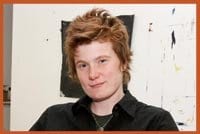The first image that catches my eye is that of a tortoise with the head and forelegs of a hare. It?s an interesting juxtaposition between the two that quickly becomes loaded with meaning.
?I like animals, and I like to look at them, I like to look at pictures of them and learn about them,? says local lesbian artist Megan Hinton. ?By combining two breeds together it would open up a dialogue about hybridity and identity, and how in painting I can transform notions of identity. These creatures talk about non-purity and it brings up notions of things like racial purity, and that it?s sort of broken down.
?My concern is for the viewer to pick something out of it, and to look at something differently. These things can?t exist in reality, obviously, but it challenges notions of what we expect to see.?
That notion of expectation is the heavy subject that Hinton hopes to explode, allowing the viewer to complete or open up the picture.
?There are so many possibilities, and I think that the possibilities of different hybrids opens up the idea of individuality,? Hinton says. ?There are people who have their own individual sense, but this body of work kind of reflects that. There are so many different possibilities of hybrids, and there are so many different possibilities of people, whichever way ? it could be racial, it could be sexuality, culturally, although it?s completely impossible for these hybrid animals to exist — although it does make a statement about cloning.?
She moves from the literal layer of cloning and genetic modification to the abstract level of the hybridity that is our multicultural society, to noting that the hybrids also represent a very queer ideal as well.
?I wanted to deal with something as a lesbian, within my community,? Hinton says, also noting that hybrids also speak to transgender issues.
?I feel pretty content with that I?m actually going into more of a political side of my work,? Hinton says, and quickly corrects herself. ?All art is political, and it makes a statement, but this is a bit more experimental.?
These works are also something of a departure for an artist primarily known as an abstract and landscape painter. ?It?s new for me, but at the same time it?s my style of painting, a lot of bold or earth-tone colours together against a white space, which is kind of a purist approach — which is ironic because the images themselves challenge the notion of purity.?
Does the message then get imparted in the medium as well?
Still, any new works for an established artist presents new challenges, particularly if they want to go further with the subject matter, as Hinton wishes. ?I?ve had some commercial success with selling my work, and I think it?s hard to move into a new body of work because you don?t know if it?s going to support you financially, you don?t know if anyone?s going to like it.?
Hinton finds that she is sensitive to the reactions of the viewers because she doesn?t want to only be concerned with what she sees on the canvas. The two best reactions she can illicit, she says, are completely offending someone or someone really loving it. Someone?s being blasé about her work is the worst.
Hinton, born and raised in Ohio and with a Master?s in Fine Art from NYU, sees her sexuality as an integral part of her art. ?When I was 23, I came out, and when I came out my art started getting a lot better,? she says. ?I was really getting in touch with myself, and there?s a certain freedom attached to that. I started painting more freely, and experimenting and doing things that I was a little uncomfortable with, and I think that played a role in pushing my work a little further.
?I think it would do that to anyone.?


 Why you can trust Xtra
Why you can trust Xtra


